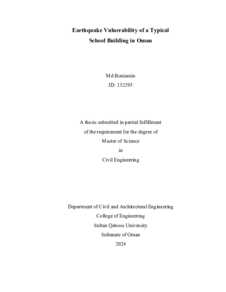وثيقة
Earthquake vulnerability of a typical school building in Oman.
المصدر
Master's thesis
الدولة
Oman
مكان النشر
Muscat
الناشر
Sultan Qaboos University
ميلادي
2024
اللغة
الأنجليزية
نوع الرسالة الجامعية
Master's thesis
الملخص الإنجليزي
The earthquake vulnerability of a typical school building in Oman is investigated in this
study. The increased attention to seismic vulnerability in educational institutions, crucial
for societal development, underscores the need for robust school buildings, especially in
earthquake-prone areas. This thesis focuses on evaluating the earthquake vulnerability of
Oman Public School, highlighting the importance of disaster risk reduction in educational
settings and providing insights to enhance safety and resilience. During construction, the
values of different building factors change, impacting how the structure reacts to
earthquakes. This uncertainty involves concrete compressive strength, reinforcement
tensile strength, cross section area, span length, storey height, mass, and ground motion
magnitude. The study highlights the need to account for these uncertainties when
assessing how well school buildings can withstand earthquakes, using fragility and
vulnerability curves. A nonlinear dynamic analysis was conducted on a three-story framedominant dual-system structure representing a typical public school in Oman, utilizing
ETABS. The OpenSees model was generated using the ETABS to OpenSees (ETO)
application and validated against the ETABS model. A Monte Carlo Simulation simulated
46 ground motions sourced from the Pacific Earthquake Engineering Research Center
(PEER), along with the specified uncertainty parameters, resulting in a pool of 4000
scenarios. The ground motions were factorized, and the OpenSees model underwent
12,801 analyses, including static, Eigen, and nonlinear dynamic analyses conducted
through MATLAB. HAZUS-MH MR4 criteria were applied to define damage states
based on maximum inter-storey drift ratios and damage ratios. Intensity measures such as
peak ground acceleration, peak ground velocity, spectral acceleration, and spectral
velocity were employed to create fragility and vulnerability curves. Both floor-level and
overall fragility curves were developed, followed by the creation of vulnerability curves.
The vulnerability curve, based on maximum spectral acceleration as per the Oman seismic
code, indicates that a 2% damage level is observed in Oman public schools. Similarly,
considering the maximum peak ground acceleration for a 475-year return period, as
outlined in the Oman seismic code, reveals no damage to the public school. These curves
offer insights into potential damages and costs based on the specified intensity measures.
قالب العنصر
الرسائل والأطروحات الجامعية

